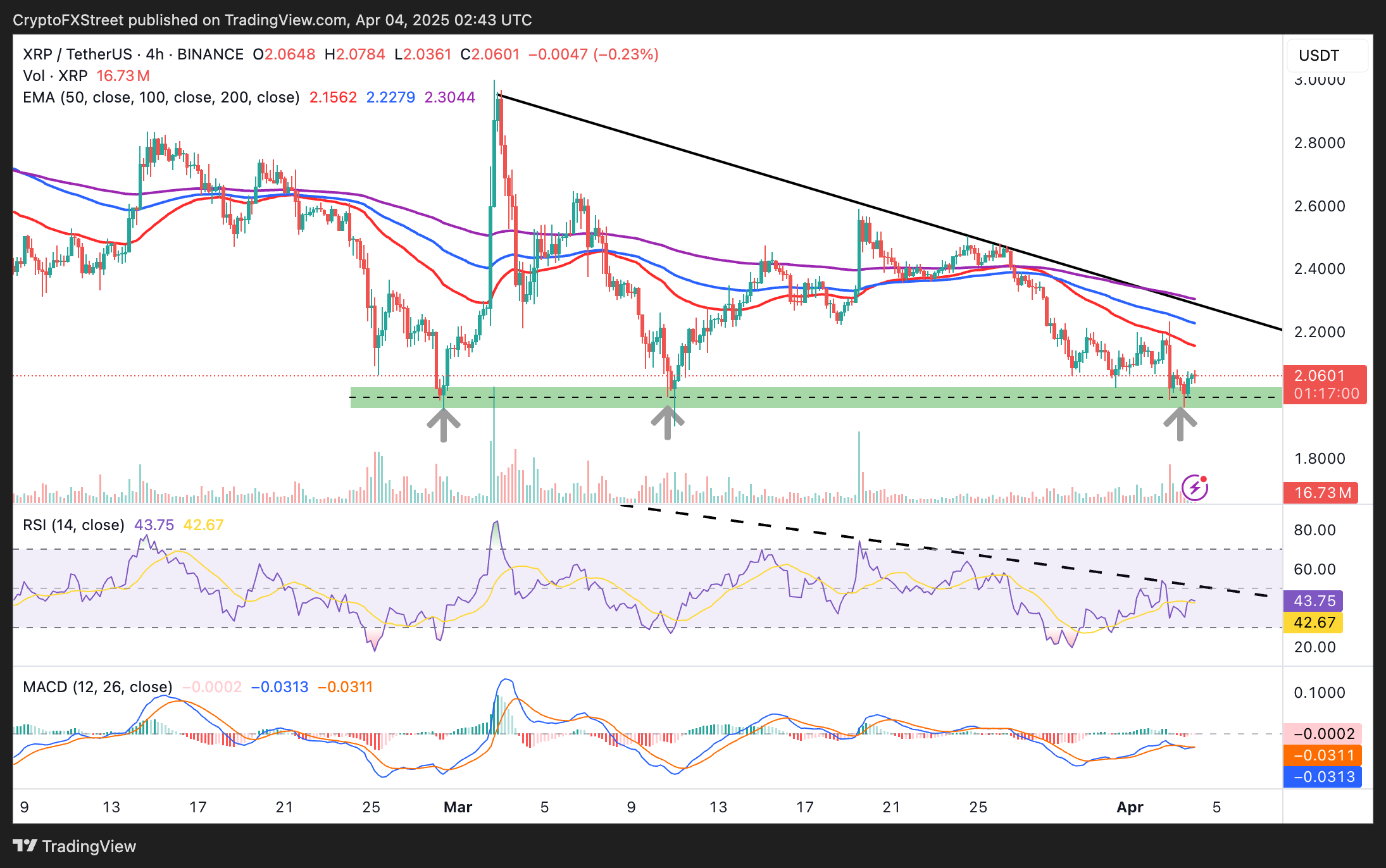- Coinbase Derivatives files with the CFTC to self-certify XRP futures, hinting at going live on April 21.
- XRP reclaims $2 support after ‘Liberation Day’ tariffs triggered a slight dip to $1.96.
- Technical indicators indicate a potential bullish turnaround, while Santiment’s MVRV sends a buy signal.
Ripple (XRP) price reclaims the $2.00 support level and trades at $2.06 at the time of writing on Friday in the wake of a drawdown to $1.96 during Thursday’s session. Traders continue to exercise caution after Trump’s tariffs hit 100 countries, as per a CryptoQuant report. Meanwhile, Coinbase Derivatives anticipates listing XRP futures later in April, this could act as a catalyst for the altcoin’s price in the mid term.
Coinbase Derivatives files with the CFTC for XRP futures
Coinbase Derivatives, a subsidiary of Coinbase focusing on regulated futures trading, announced via an X post that it had submitted a self-certification application to the Commodity Futures Trading Commission (CFTC) to list XRP futures contracts. If approved, the exchange could go live with the futures contracts on April 21, 2025, adding to its growing list of regulated assets, including Bitcoin (BTC), Ethereum (ETH) and Solana (SOL), among others.
We’re excited to announce that Coinbase Derivatives has filed with the CFTC to self-certify $XRP futures – bringing a regulated, capital-efficient way to gain exposure to one of the most liquid digital assets.
We anticipate the contract going live on April 21, 2025.
Stay tuned… pic.twitter.com/nKUPjjnMKW
— Coinbase Institutional ️ (@CoinbaseInsto) April 3, 2025
The application is monumental for XRP, a token directly linked to Ripple Labs, which was entangled in a four-year legal battle with the Securities and Exchange Commission (SEC). XRP has historically faced challenges with classification, but with the SEC dropping the lawsuit against Ripple in March 2025, the token could turn a new leaf, paving the way for more regulated investment vehicles such as exchange-traded funds (ETFs).
Following the futures contracts announcement, open interest surged 0.74% to $3.65 billion, according to Coinglass data. Rising open interest (OI) suggests that new positions are being opened in derivatives markets (futures/options). It is also indicative of growing market participation among traders and capital inflow.
XRP futures open interest
Despite the spike in OI, volatility could remain a major concern across the cryptocurrency market. The fear and greed index has recovered slightly from 25 (extreme fear) recorded on Thursday due to ‘Liberation Day’ tariffs to 28 at the time of writing. Risk-off sentiment tends to grip investors during such conditions, which could push XRP below its $2.00 support.
Crypto fear & greed index | Source: Alternative.me
XRP technicals could flip bullish on one condition
XRP sits above $2.00, a support that the token respected on February 28 and March 11, 2025. Traders will require confirmation that this level is strong enough to hold and limit downside exposure to book more long positions in the next few days.
The Relative Strength Index (RSI) is higher than the previous day’s low of 35. However, it must extend from 42 (its current position), above the trendline resistance, to validate a sustainable XRP recovery to $2.50 and $3.00, respectively.
XRP/USDT 4-hour price chart
The Moving Average Convergence Divergence (MACD) stuck below the meanline points to the apparent sell-side pressure. However, traders should consider watching out for a confirmed buy signal if the MACD crosses above the moving average and starts moving aggressively upwards.
Investors may want to consider Santiment’s Market Value Realized Value (MVRV) ratio as a buy signal. In the chart below, the MVRV sits 27.44% below XRP’s intrinsic value.
XRP MVRV ratio | Source: Santiment
In other words, many investors are holding the asset at a loss and are unlikely to sell as they would realize a loss. As this may translate to reduced selling pressure, XRP bulls could find room to wiggle, breaking through and pushing for drastic recovery.
Bitcoin, altcoins, stablecoins FAQs
Bitcoin is the largest cryptocurrency by market capitalization, a virtual currency designed to serve as money. This form of payment cannot be controlled by any one person, group, or entity, which eliminates the need for third-party participation during financial transactions.
Altcoins are any cryptocurrency apart from Bitcoin, but some also regard Ethereum as a non-altcoin because it is from these two cryptocurrencies that forking happens. If this is true, then Litecoin is the first altcoin, forked from the Bitcoin protocol and, therefore, an “improved” version of it.
Stablecoins are cryptocurrencies designed to have a stable price, with their value backed by a reserve of the asset it represents. To achieve this, the value of any one stablecoin is pegged to a commodity or financial instrument, such as the US Dollar (USD), with its supply regulated by an algorithm or demand. The main goal of stablecoins is to provide an on/off-ramp for investors willing to trade and invest in cryptocurrencies. Stablecoins also allow investors to store value since cryptocurrencies, in general, are subject to volatility.
Bitcoin dominance is the ratio of Bitcoin’s market capitalization to the total market capitalization of all cryptocurrencies combined. It provides a clear picture of Bitcoin’s interest among investors. A high BTC dominance typically happens before and during a bull run, in which investors resort to investing in relatively stable and high market capitalization cryptocurrency like Bitcoin. A drop in BTC dominance usually means that investors are moving their capital and/or profits to altcoins in a quest for higher returns, which usually triggers an explosion of altcoin rallies.





%20[05.40.24,%2004%20Apr,%202025]-638793389571879690.png)